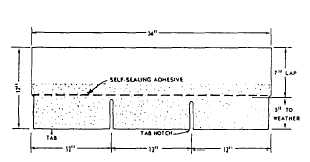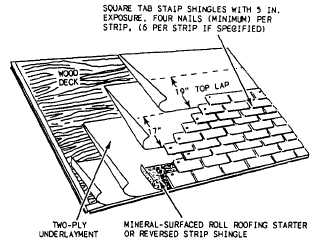course. This waterproofs the joint between a sloping
roof and vertical wall. This is generally called step
flashing.
As each course of shingles is laid, a metal flashing
shingle is installed and nailed at the top edge as shown.
Do not nail flashing to the wall; settling of the roof frame
could damage the seal.
Wall siding is installed after the roof is completed.
It also serves as a cap flashing. Position the siding just
above the roof surface. Allow enough clearance to paint
the lower edges.
Roof Cements
Roofing cements are used for installing cave
flashing, for flashing assemblies, for cementing tabs of
asphalt shingles and laps in sheet material, and for
repairing roofs. There are several types of cement,
including plastic asphalt cements, lap cements,
quick-setting asphalt adhesives, roof coatings, and
primers. The type and quality of materials and methods
of application on a shingle roof should follow the
recommendation of the manufacturer of the shingle
roofing.
Exterior
Basically, exterior roof treatment consists of
applying various products, including shingles, roll
roofing, tiles, slate, and bituminous coverings.
Treatment also includes specific construction
considerations for ridges, hips, and valleys.
SHINGLES.— The two most common shingle
types are asphalt and fiberglass, both of which come in
various strip shapes.
Asphalt.— Asphalt (composition) shingles are
available in several patterns. They come in strip form or
as individual shingles. The shingles are manufactured
on a base of organic felt (cellulose) or an inorganic glass
mat. The felt or mat is covered with a mineral-stabilized
coating of asphalt on the top and bottom. The top side
is coated with mineral granules of specified color. The
bottom side is covered with sand, talc, or mica.
Fiberglass.— Improved technologies have made
the fiberglass mat competitive with organic felt. The
weight and thickness of a fiberglass mat is usually less
than that of organic felt. A glass fiber mat maybe 0.030
inch thick versus 0.055 inch thick for felt. The
popularity of fiberglass-based shingles is their low cost.
The mat does not have to be saturated in asphalt. ASTM
standards specify 3 pounds per 100 feet. The
Figure 3-22.-A typical 12- by 36-inch shingle.
Figure 3-23.-Special shingle application.
combination of glass fiber mats with recently developed
resins has significantly lowered the price of composition
shingles.
Strip.— One of the most common shapes of asphalt
or fiberglass shingles is a 12- by 36-inch strip (fig. 3-22)
with the exposed surface cut or scored to resemble three
9-by 12-2- inch shingles. These are called strip shingles.
They are usually laid with 5 inches exposed to the
weather. A lap of 2 to 3 inches is usually provided over
the upper edge of the shingle in the course directly
below. This is called the head lap.
The thickness of asphalt shingles may be uniform
throughout, or, as with laminated shingles, slotted at the
butts to give the illusion of individual units. Strip
shingles are produced with either straight-tab or
random-tab design to give the illusion of individual units
or to simulate the appearance of wood shakes. Most strip
shingles have factory-applied adhesive spaced at
intervals along the concealed portion of the strip. These
strips of adhesive are activated by the warmth of the sun
and hold the shingles firm through wind, rain, and snow.
Strip shingles are usually laid over a single
thickness of asphalt-saturated felt if the slope of the roof
3-18



